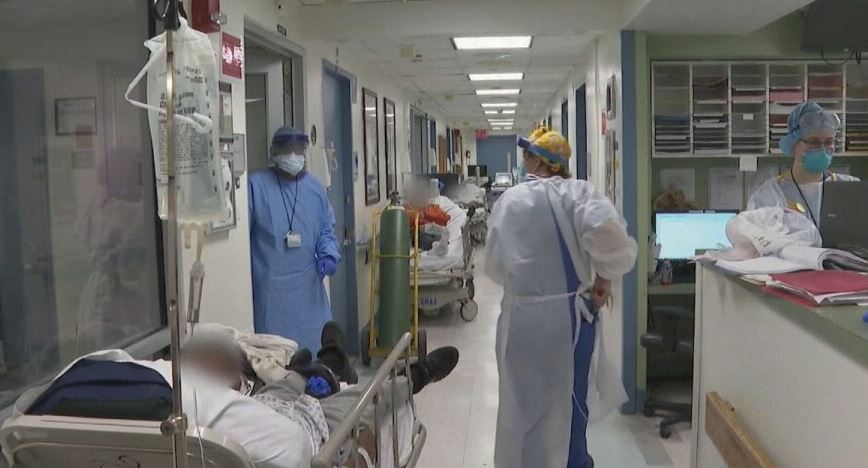Coronavirus Batters US Economy in 2020; Performance Weakest in 74 Years
WASHINGTON– The US economy contracted at its sharpest pace since World War Two in 2020 as the COVID-19 pandemic depressed consumer spending and business investment, pushing millions of Americans out of work and into poverty.
The Commerce Department’s snapshot of fourth-quarter gross domestic product on Thursday also showed the recovery from the pandemic losing steam as the year wound down amid a resurgence in coronavirus infections and exhaustion of nearly $3 trillion in relief money from the government.
President Joe Biden has unveiled a recovery plan worth $1.9 trillion, and could use the GDP report to lean on some lawmakers who have balked at the price tag soon after the government provided nearly $900 billion in additional stimulus at the end of December.
The Federal Reserve on Wednesday left its benchmark overnight interest rate near zero and pledged to continue injecting money into the economy through bond purchases, noting that “the pace of the recovery in economic activity and employment has moderated in recent months.”
The economy contracted 3.5% in 2020, the worst performance since 1946. That followed 2.2% growth in 2019 and was the first annual decline in GDP since the 2007-09 Great Recession. Nearly every sector, with the exception of government and the housing market, suffered a decline in output last year. The 3.9% drop in consumer spending was the largest since 1932.
The economy plunged into recession last February. In the fourth quarter, GDP increased at a 4.0% annualized rate as the virus and lack of another spending package curtailed consumer spending, and partially overshadowed robust manufacturing and the housing market. GDP growth for the last quarter was in line with forecasts in a Reuters poll of economists.
The big step-back after a historic 33.4% growth pace in the July-September period left GDP 2.5% below its level at the end of 2019. With the virus not yet under control, economists are expecting growth to further slow down in the first quarter of 2021, before regaining speed by summer as the additional stimulus kicks in and more Americans get vaccinated.
The services sector has borne the brunt of the coronavirus recession, disproportionately impacting lower-wage earners, who tend to be women and minorities. That has led to a so-called K-shaped recovery, where better-paid workers are doing well while lower-paid workers are losing out.
U.S. stocks opened higher. The dollar slipped against a basket of currencies. U.S. Treasury prices were lower.
WEAK LABOR MARKET
The stars of the recovery have been the housing market and manufacturing as those who are still employed seek larger homes away from city centers, and buy electronics for home offices and schooling. Manufacturing’s share of GDP has increased to 11.9% from 11.6% at the end of 2019.
A survey last week by professors at the University of Chicago and the University of Notre Dame showed poverty increased by 2.4 percentage points to 11.8% in the second half of 2020, boosting the ranks of the poor by 8.1 million people.
Rising poverty was underscored by persistent labor market weakness. In a separate report on Thursday, the Labor Department said initial claims for state unemployment benefits totaled a seasonally adjusted 847,000 for the week ended Jan. 23. While that was down 67,000 from the prior week, claims remain well above their 665,000 peak during the 2007-09 Great Recession.
Including a government-funded program for the self-employed, gig workers and others who do not qualify for the regular state unemployment programs 1.3 million people filed claims last week.
The economy shed jobs in December for the first time in eight months. Only 12.4 million of the 22.2 million jobs lost in March and April have been recovered. About 18.3 million Americans were receiving unemployment checks in early 2021.
Lack of jobs and the expiration of a government weekly jobless subsidy restrained growth in consumer spending to about a 2.5% rate in the fourth quarter. Consumer spending, which accounts for more than two-thirds of the U.S. economy, notched a record 41% growth pace in the July-September quarter.
Business investment grew at a 13.8% rate, with spending on equipment rising at a 24.9% pace. There were also increases in spending on nonresidential structures and intellectual property.
Businesses also accumulated inventories last quarter, which contributed to GDP growth. But the inventory accumulation included imports, leading to a larger trade deficit, which subtracted from growth.
The housing market recorded another quarter of double-digit growth, thanks to historically low mortgage rates. Government spending was weak, hurt by state and local governments, whose finances have been squeezed by the pandemic.
SOUCRCE: REUTERS

